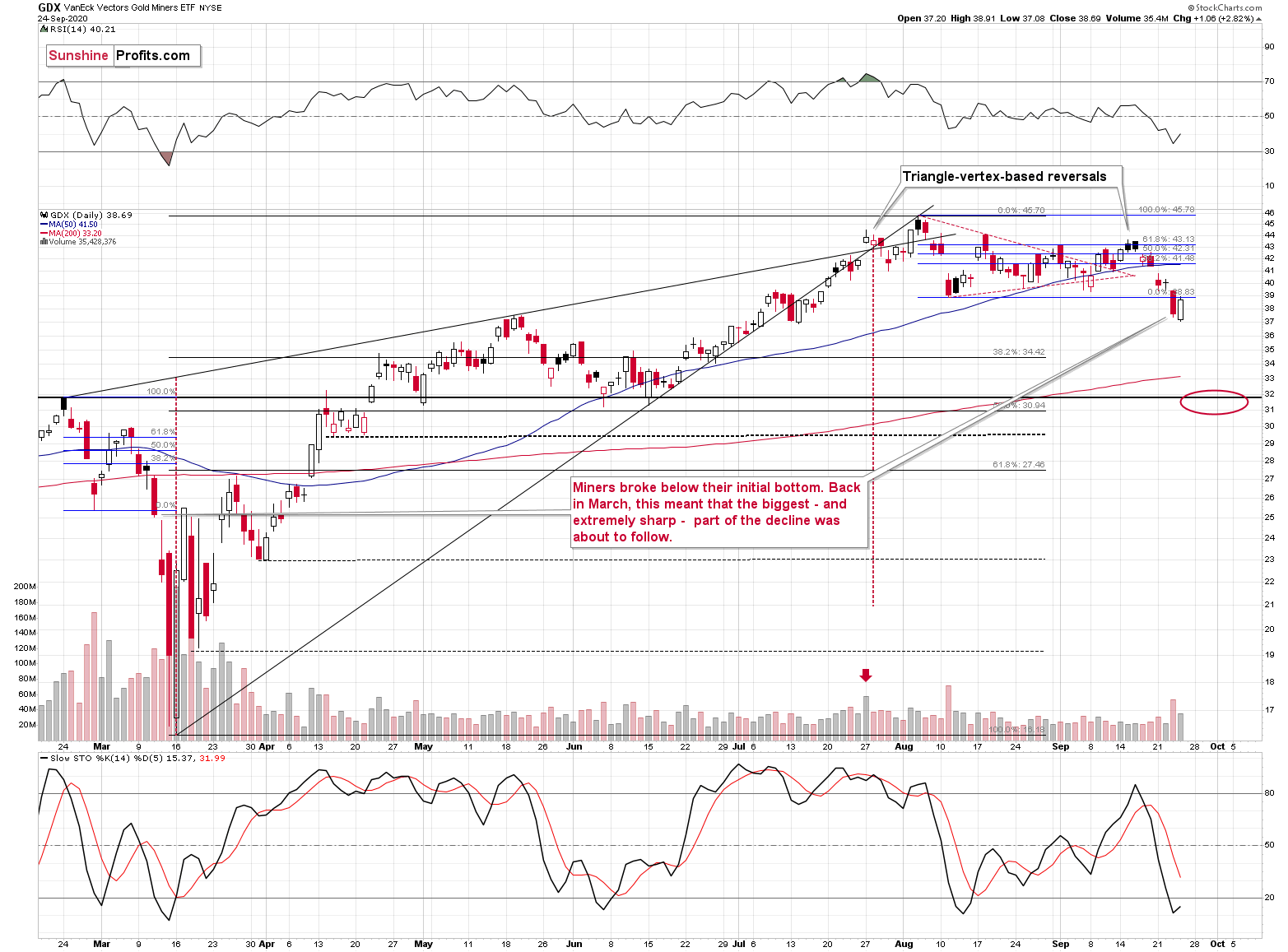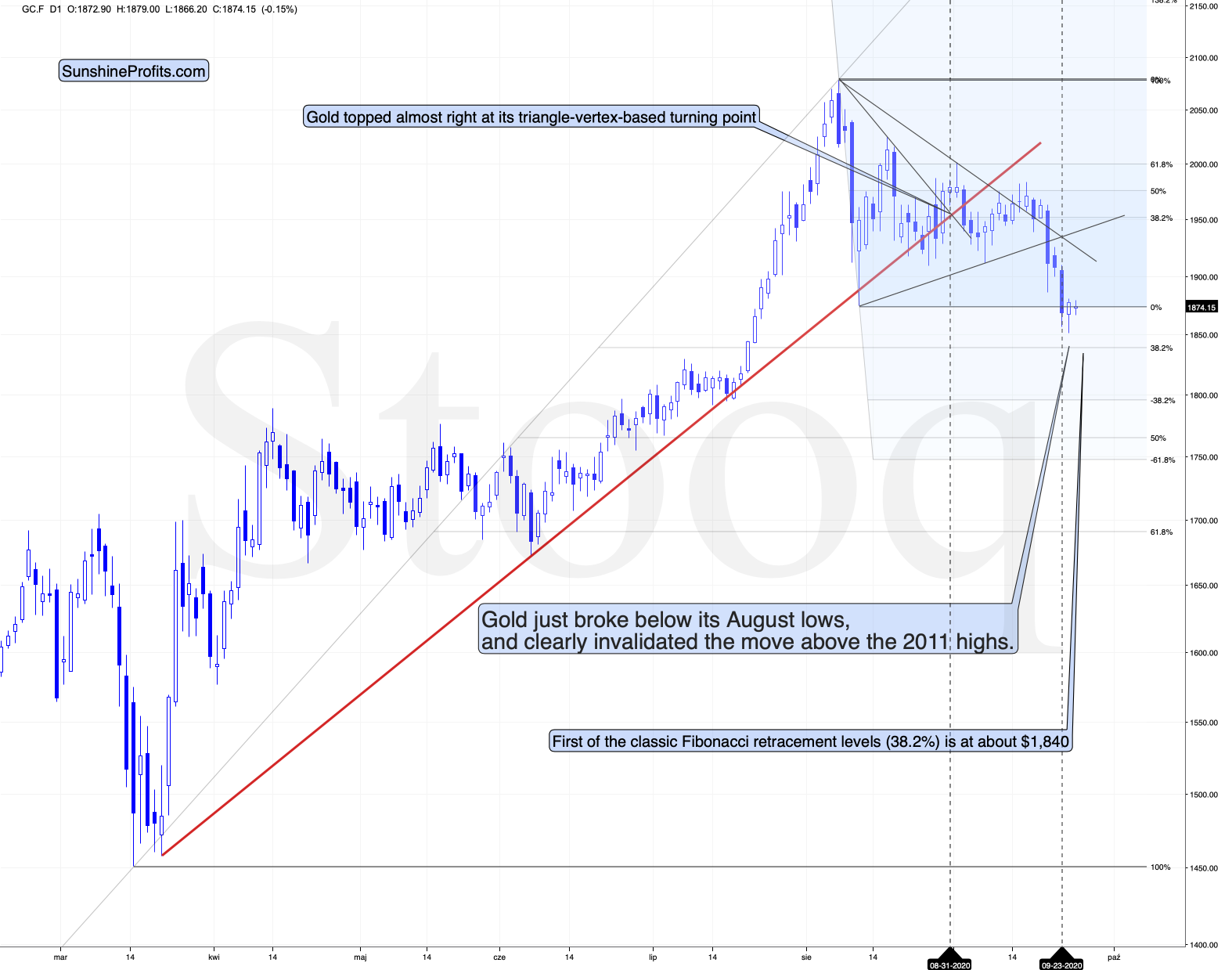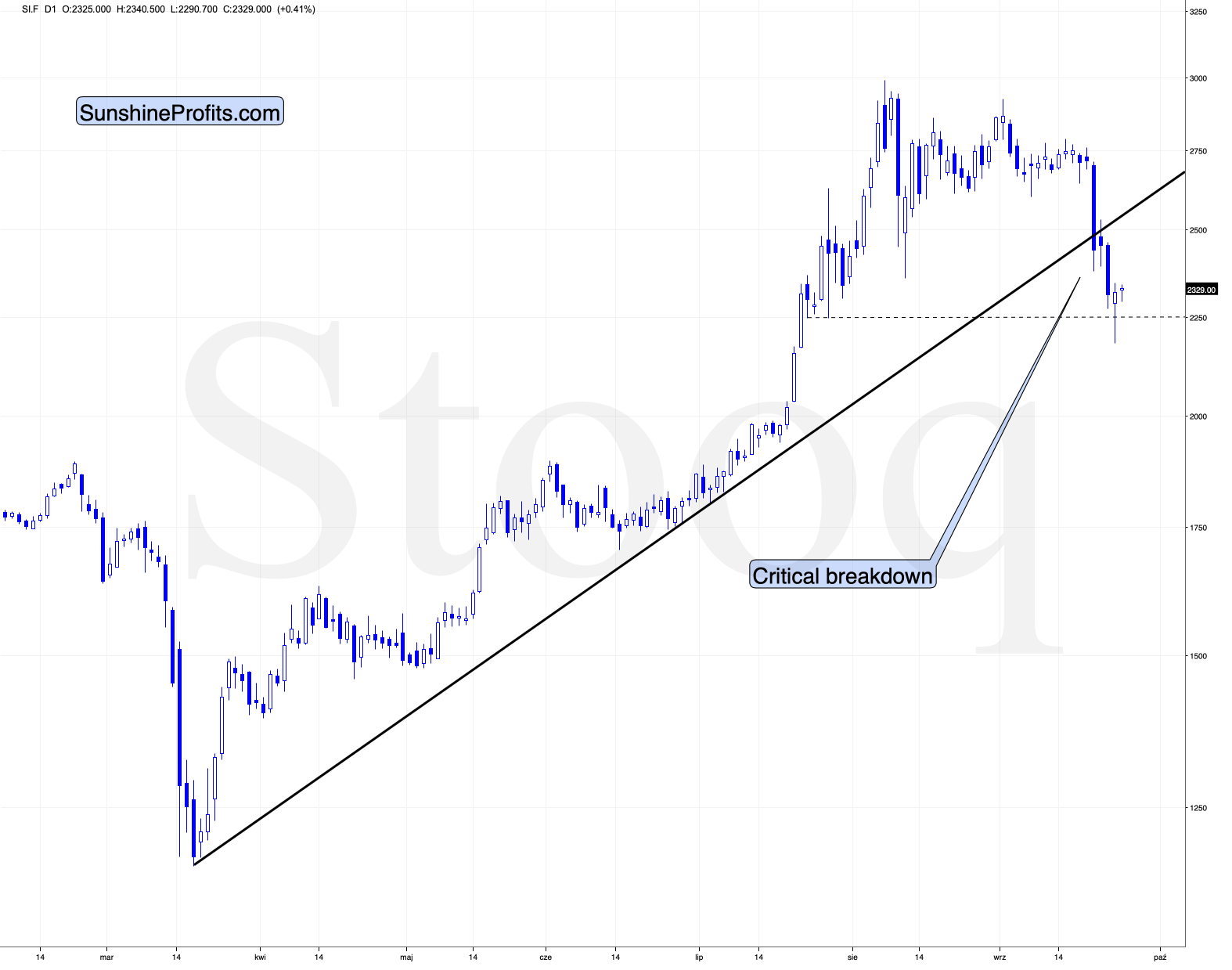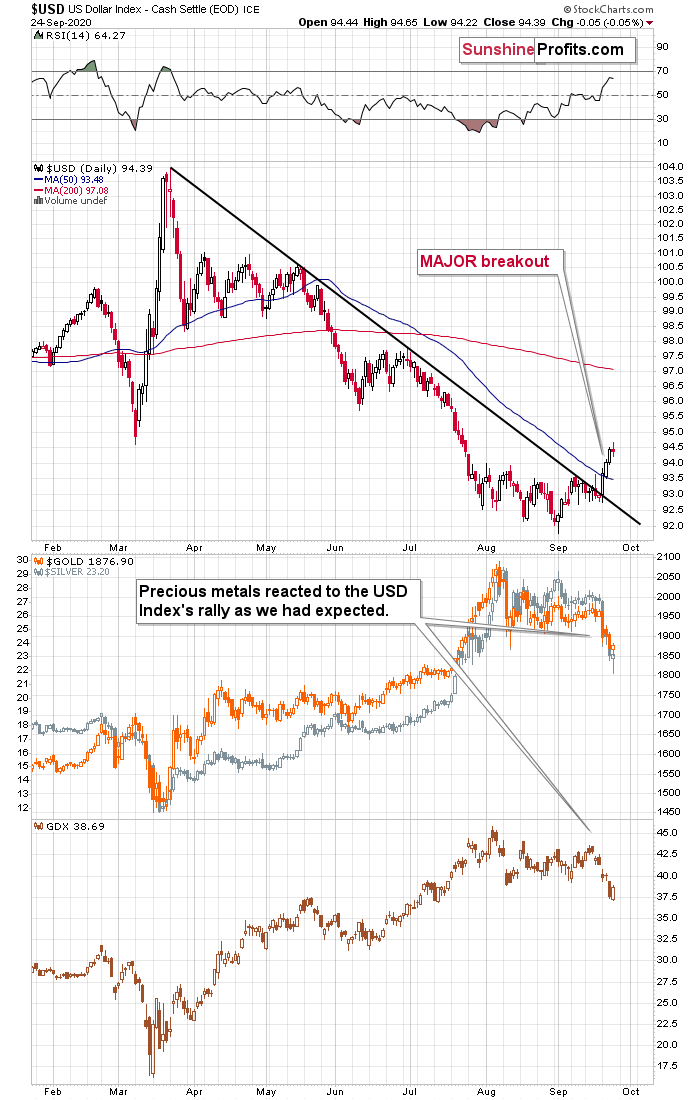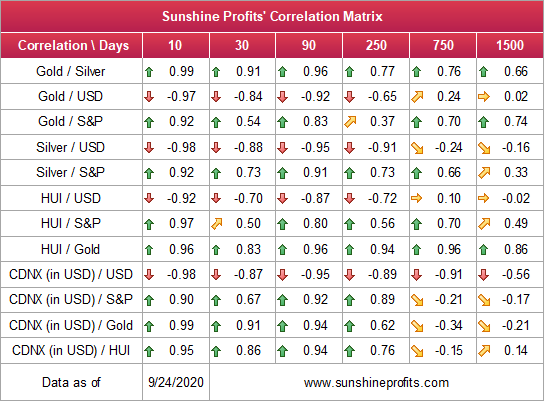Briefly: in our opinion, full (300% of the regular position size) speculative short positions in mining stocks are justified from the risk/reward point of view at the moment of publishing this Alert.
Let's begin with what we wrote in yesterday's analysis regarding the mining stocks:
Miners just broke below their initial - August - bottom. This doesn't seem to be a big deal, until one realizes that the very same thing was the final moment to enter short positions in miners, and in the precious metals sector in general.
And the situation is similar between both periods. The key difference is that the USD Index bottomed in broad fashion this time, and it bottomed in a sharp fashion in March. The additional difference is the performance of the general stock market. It was declining in March, and this time it soared to new highs and then invalidated this breakout.
In the previous weeks we warned you that the soaring stocks would likely prolong the pause in the miners and that's exactly what happened.
What's the take-away?
The take-away is that miners could plunge shortly and sharply, and this possibility alone is enough for us to think that limiting the positions now would not be a good idea.
We'd give the above about 30% probability, though. The more likely outcome (40% or so) is that the decline will be slower this time and/or that it will be preceded by a pause. The latter would correspond to the triangle-vertex-based reversal in gold. The above doesn't add up to 100% - the remaining 30% is for all other scenarios combined (like, another test of the recent highs, breakout to new highs, very long consolidation at the current levels and everything in between).
And what happened next?
Well, the most likely outcome happened. Mining stocks moved higher and paused after the decline. They have done so in the most bearish way - they moved higher, but they didn't close the day above the August lows, meaning that the breakdown below them was not invalidated.
So, what did gold do as a response?
Gold paused, which is not surprising given what we wrote about its situation:
Gold broke below the August lows, making it clear that the previous 2020 rally is over. To be honest, it was already clear when gold confirmed the breakdown below the rising red support line, confirmed the breakdown, and then even verified it by moving a bit higher, but failing to rally back above it. The current slide is only the consequence of what was already clear previously.
The breakdown below the August lows is not even the most important thing that just happened in gold. The key thing is that gold decisively invalidated its breakout above the 2011 highs.
The central banks around the world are printing money like crazy - much crazier than what we saw before 2020... Why wasn't gold able to hold the previous gains? Something doesn't add up...
The reason is the same reason why silver and mining stocks managed to only correct about half of their declines from the 2011 highs, instead of following gold to new highs. And that reason is:
Gold, and the rest of the precious metals sector was not ready to rally yet as it didn't fully complete its bearish cycle, and whatever happened this year was a massive interruption in the cycle that didn't end it.
The decline that gold was likely to take place, and instead if was forced to rally. But this rally didn't hold, and since gold just invalidated the breakout above its 2011 highs, it seems that we'll see a huge decline, anyway. And the bearish cycle will then - and only then - be completed.
Gold's triangle-vertex-based reversal was yesterday, which means that we could see some kind of correction or a pause shortly. Perhaps as early as today.
That's exactly what happened. We've detected a pause that was likely triggered by the triangle-vertex-based reversal.
Something similar happened in silver as well. As far as the white metal is concerned, we've found the following:
Silver is also after a major breakdown and it just moved slightly below the recent intraday lows, which could serve as short-term support. This support is not significant enough to trigger any major rally, but it could be enough to trigger a dead-cat bounce, especially if gold does the same thing.
Once again, that is precisely what happened.
At this point, one might ask how we can know if that really is just a dead-cat bounce and not a beginning of a new strong upleg in the precious metals sector. The response would be that while in any marketplace, nobody can say anything for sure, the dead-cat-bounce scenario is conceivable because of multiple factors, the clearest of them being the confirmed breakdowns in gold and silver, and most importantly, the confirmed USDX breakout. The breakout's invalidation above the previous 2020 highs in the general stock market is also a bearish factor, particularly for mining stocks (and silver).
There are also long-term reasons to think that this move is not over yet (e.g., gold's performance after its very long-term turning points and its self-similar pattern), and we've discussed them all in this week's flagship Gold & Silver Trading Alert.
The above short-term USD Index chart shows us exactly how clear the breakout above the declining resistance line and the 50-day moving average really was. It's big, more than verified, and very bullish for the upcoming weeks.
Since gold, silver, and mining stocks have been strongly negatively correlated with the USD Index in the short (30-day column) and medium-term (90-day column), it seems likely that they will continue to be negatively affected by the USDX upswing.
Taking everything into account, the implications for the precious metals market are very bearish.
Overview of the Upcoming Decline
As far as the current overview of the upcoming decline is concerned, I think it has already begun.
During the final part of the slide (which could end later than in 6 weeks, perhaps near the end of the year - just like it happened in 2015), we expect silver to decline more than miners. That would be aligned with how the markets initially reacted to the Covid-19 threat.
The impact of all the new rounds of money printing in the U.S. and Europe on the precious metals prices is incredibly positive in the long run, but it doesn't make the short-term decline improbable. Markets can and will get ahead of themselves and then decline - sometimes very profoundly - before continuing with their upward march.
The plan is to exit the current positions in miners after they decline far and fast, but at the same time, when silver drops just "significantly" (we expect this to happen in 0 - 5 weeks). In other words, the decline in silver should be severe, but the decline in the miners should look "ridiculous". That's what we did in March when we bought practically right at the bottom. This is a very soft and broad instruction, so additional confirmations are necessary. I expect this confirmation to come from gold, reaching about $1,800. If - at the same time - gold moves to about $1,800 and miners are already after a ridiculously big drop (say, to $31 - $32 in the GDX ETF - or lower), we will probably exit the short positions in the miners and at the same time enter short positions in silver. It will be tempting to wait with opening the short position in silver until the entire sector rebounds, but such a rebound could last only a couple of hours, so it would be challenging to successfully execute such a strategy.
Summary
Summing up, considering gold's invalidation of its breakout above the 2011 highs, it's clear that the rally (that ended $4 above our upside target) is entirely over. Given this invalidation and the confirmed USD Index breakout, gold will probably slide much lower over the next few weeks. That may (based on miners' breakdown) or may not (based on gold's triangle-vertex-based reversal) happen right away, or it will take place after several days of pause or a small correction, but it will most probably happen.
Naturally, everyone's trading is their responsibility. But in our opinion, if there ever was a time to either enter a short position in the miners or increase its size if it wasn't already sizable, it's now. We made money on the March decline and on the March rebound, and another massive slide is already underway.
After the sell-off (that takes gold to about $1,700 or lower), we expect the precious metals to rally significantly. The final decline might take as little as 1-6 weeks, so it's important to stay alert to any changes.
Needless to say, the most important thing is to stay healthy and safe. We made a lot of money on the March decline and the subsequent rebound (its initial part) price moves (and we'll likely make much more in the following weeks and months), but you have to be healthy to really enjoy the results.
As always, we'll keep you - our subscribers - informed.
To summarize:
Trading capital (supplementary part of the portfolio; our opinion): Full speculative short positions (300% of the full position) in mining stocks is justified from the risk to reward point of view with the following binding exit profit-take price levels:
Senior mining stocks (price levels for the GDX ETF): binding profit-take exit price: $32.02; stop-loss: none (the volatility is too big to justify a SL order in case of this particular trade); binding profit-take level for the DUST ETF: $28.73; stop-loss for the DUST ETF: none (the volatility is too big to justify a SL order in case of this particular trade)
Junior mining stocks (price levels for the GDXJ ETF): binding profit-take exit price: $42.72; stop-loss: none (the volatility is too big to justify a SL order in case of this particular trade); binding profit-take level for the JDST ETF: $21.22; stop-loss for the JDST ETF: none (the volatility is too big to justify a SL order in case of this particular trade)
For-your-information targets (our opinion; we continue to think that mining stocks are the preferred way of profiting from the upcoming price move, but if for whatever reason one wants / has to use silver or gold for this trade, we are providing those details anyway. In our point of view, currently, silver has greater potential than gold does):
Silver futures downside profit-take exit price: unclear at this time - initially, it might be a good idea to exit, when gold moves to $1,703.
Gold futures downside profit-take exit price: $1,703
Long-term capital (core part of the portfolio; our opinion): No positions (in other words: cash
Insurance capital (core part of the portfolio; our opinion): Full position
Whether you already subscribed or not, we encourage you to find out how to make the most of our alerts and read our answers to the most common alert-and-gold-trading-related-questions.
Please note that the in the trading section we describe the situation for the day that the alert is posted. In other words, it we are writing about a speculative position, it means that it is up-to-date on the day it was posted. We are also featuring the initial target prices, so that you can decide whether keeping a position on a given day is something that is in tune with your approach (some moves are too small for medium-term traders and some might appear too big for day-traders).
Plus, you might want to read why our stop-loss orders are usually relatively far from the current price.
Please note that a full position doesn't mean using all of the capital for a given trade. You will find more details on our thoughts on gold portfolio structuring in the Key Insights section on our website.
As a reminder - "initial target price" means exactly that - an "initial" one, it's not a price level at which we suggest closing positions. If this becomes the case (like it did in the previous trade) we will refer to these levels as levels of exit orders (exactly as we've done previously). Stop-loss levels, however, are naturally not "initial", but something that, in our opinion, might be entered as an order.
Since it is impossible to synchronize target prices and stop-loss levels for all the ETFs and ETNs with the main markets that we provide these levels for (gold, silver and mining stocks - the GDX ETF), the stop-loss levels and target prices for other ETNs and ETF (among other: UGLD, DGLD, USLV, DSLV, NUGT, DUST, JNUG, JDST) are provided as supplementary, and not as "final". This means that if a stop-loss or a target level is reached for any of the "additional instruments" (DGLD for instance), but not for the "main instrument" (gold in this case), we will view positions in both gold and DGLD as still open and the stop-loss for DGLD would have to be moved lower. On the other hand, if gold moves to a stop-loss level but DGLD doesn't, then we will view both positions (in gold and DGLD) as closed. In other words, since it's not possible to be 100% certain that each related instrument moves to a given level when the underlying instrument does, we can't provide levels that would be binding. The levels that we do provide are our best estimate of the levels that will correspond to the levels in the underlying assets, but it will be the underlying assets that one will need to focus on regarding the signs pointing to closing a given position or keeping it open. We might adjust the levels in the "additional instruments" without adjusting the levels in the "main instruments", which will simply mean that we have improved our estimation of these levels, not that we changed our outlook on the markets. We are already working on a tool that would update these levels on a daily basis for the most popular ETFs, ETNs and individual mining stocks.
Our preferred ways to invest in and to trade gold along with the reasoning can be found in the how to buy gold section. Additionally, our preferred ETFs and ETNs can be found in our Gold & Silver ETF Ranking.
As a reminder, Gold & Silver Trading Alerts are posted before or on each trading day (we usually post them before the opening bell, but we don't promise doing that each day). If there's anything urgent, we will send you an additional small alert before posting the main one.
Thank you.
Sincerely,
Przemyslaw Radomski, CFA
Editor-in-chief, Gold & Silver Fund Manager


